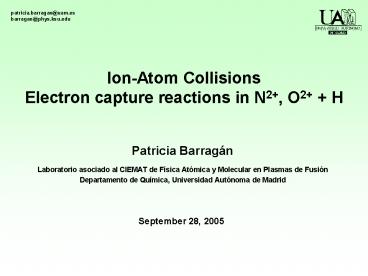Ion-Atom Collisions Electron capture reactions in N2 , O2 H - PowerPoint PPT Presentation
1 / 30
Title:
Ion-Atom Collisions Electron capture reactions in N2 , O2 H
Description:
Laboratorio asociado al CIEMAT de F sica At mica y Molecular en Plasmas de Fusi n ... GTO bases (Widmark et al. Theor.Chim. Acta. 77, 291 (1990) ... – PowerPoint PPT presentation
Number of Views:20
Avg rating:3.0/5.0
Title: Ion-Atom Collisions Electron capture reactions in N2 , O2 H
1
Ion-Atom CollisionsElectron capture reactions in
N2, O2 H
patricia.barragan_at_uam.es barragan_at_phys.ksu.edu
- Patricia Barragán
- Laboratorio asociado al CIEMAT de Física Atómica
y Molecular en Plasmas de Fusión - Departamento de Química, Universidad Autónoma de
Madrid
September 28, 2005
2
Motivation
- Fusion plasmas.
- Plasma-wall interaction
Impurities. - Plasma diagnostics (CXS).
- Astrophysics.
- Comets X-ray emission .
3
- N2 H and O2 H collisions.
- Presence of metastable ions in beams.
- Calculation of rate coefficients.
- Computational characteristics
- Many electron systems. Use of Quantum Chemistry
techniques. - Calculation in a wide energy range Quantal and
semiclassical treatments.
4
N2 H collisions
Reaction (1)
Reaction (2)
5
O2 H collisions
- Reaction (3)
Reaction (4)
Reaction (5)
6
Quantal treatment
- Schrödinger equation
- Boundary conditions (one electron systems)
7
Molecular expansion
?k are eigenfunctions of Helec
? is the Common Reaction Coordinate, which
ensures that a truncated expansion satisfies the
scattering boundary conditions
8
Cross Sections
are solutions of the system of differential
equations
The total Cross Section for transition i?j is
given by
9
Semiclassical treatment
- The nuclei follow straight-line trajectories
- The electronic motion is described by the eikonal
equation - Molecular close-coupling treatment
- where D(r,t) is a common translation factor.
10
Cross Sections
where the probability Pij for transition to the
final state is calculated from the coefficient
aj(t)
11
Computational scheme
- Calculation of electronic energiesMRCI (MELDF)
- - GTO bases (Widmark et al. Theor.Chim. Acta. 77,
291 (1990)) - - 80 reference configurations, iterative process
to select the set of reference configurations at
each R. - - Frozen core approximation.
- - Perturbative selection.
- Calculation of dynamical couplings.
- - Numerical differentation (Castillo et al. J
Chem. Phys. 03,2113(1995)) - - Sign consistency calculation of the delayed
overlap matrix (Errea et al. J Chem. Phys.
121,1663 (2004))
12
N2 H Potential energy curves singlets
c.e.
13
N2 H Potential energy curves triplets
c.e.
c.e.
14
N2 H Potential energy curves triplets
15
N2 H Potential energy curves triplets
16
N2 H Potential energy curves quintets
17
N2 H Total cross sections
18
N2 H Total cross sections
19
N2 H Total cross sections
20
N2 H Total cross sections
21
N2 H Branching ratios
22
O2 H Potential energy curves doublets
23
O2 H Potential energy curves cuadruplets
24
O2 H Total cross sections
25
O2 H Total cross sections
26
O2 H Branching ratios
27
Rate coefficients
28
Rate coefficients
29
Concluding remarks
- N2 H, O2 H collisions.
- Quantal calculation for low energy and
semiclassical for high energy. - Presence of metastable ions in beams Possible
presence of N2(2s2p2 4P) in merged beams
experiments. Not noted in other experiments. - Very large cross sections at low energies - shape
resonances? - Calculation of partial EC cross sections
(diagnostics).
30
Thanks to
- L. Méndez, I. Rabadán, L. F. Errea and A. Riera
- who have participated directly in this work.
- And the other group members
- L. Fernández, F. Guzmán, C. Illescas, A. Macías
- and J. Suarez
- Group web-site http//tcam.qui.uam.es










![How much kinetic energy must a deuterium ion (charge = 1.6 x 10-19 C) have to approach within 10-14 m of another deuterium ion? [k = 9 x 109 N-m2 /C2 and 1 MeV = 1.6 x 10-13 J] PowerPoint PPT Presentation](https://s3.amazonaws.com/images.powershow.com/A1258150491bvXhS.th0.jpg?_=20140125051)




















